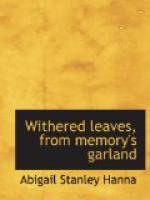Here, side by side, are the graves of an entire household, consisting of the maternal grandmother, two sisters of the father, the father and mother, and seven children, with the wife of one of the sons. Not twelve rods from their own door they sleep side by side—that many voiced household, in the silence of death. No voice breaks the stillness; no words of love are interchanged; but their dust shall mingle together till the morning of the resurrection, teaching an impressive lesson to those that stand by their graves and read the inscriptions upon their tombstones.
Here is buried the dear old deacon and his wife, by whose bedside we stood when his forehead was wet with the damp dews of death, and his eye lighted up by faith, seemed to scan the glories of the upper world, and he felt it was “far better to depart and be with Christ.” And even then came, “let me die the death of the righteous, and let my last end be like his.” His devoted, pious wife soon followed him, and we feel, as we look upon their graves, there is rest in Heaven. At their feet lie children, grand-children and great-grand-children.
Clara Everett was a promising young girl, cut down at the early age of nineteen. She was left an orphan at the age of nine months, her father dying suddenly, and her mother a few weeks after, with consumption. She was tenderly cared for by her maternal grand-parents and a maiden aunt, well educated and had commenced teaching, when she was seized suddenly with an alarming fever, which in a few short days, was terminated by death. They bore her to the resting place with many tears, and placed her beside those dear parents from whom she was so early separated. Many here, that lived a life of dissipation, have gone down to fill a drunkard’s grave;
“But we’ll tread lightly on the ashes of the dead.”
Why should we uncover the frailties of poor mortality, unless to hold them up as beacon lights to the rising generation? and for this purpose we would take the living example.
Here is buried an aged woman, who lived in poverty. She had the shaking palsy, and it was with great difficulty she could perform any labor; she was assisted by the town and the charities of the neighborhood. She had one daughter, who was an invalid many years, and dependant upon the care of the feeble mother. The children of the village were the willing bearers of many comforts to these poor people; and even now seems to come the well remembered “tell your mother I am much obliged to her,” from the pale lips that lie buried beneath the sod. The daughter is buried by her side, and methinks they sleep as sweetly as the more wealthy citizen, beneath a more splendid monument. All here meet upon a common level—the old, the young, the rich, the poor, the bond and free, for death is no respecter of persons.
Here, too, rests a young physician, who supplied the place of the old one. His career was like the meteor flash, emitting its brilliant rays for a season, and then was shrouded in death’s dark night.




